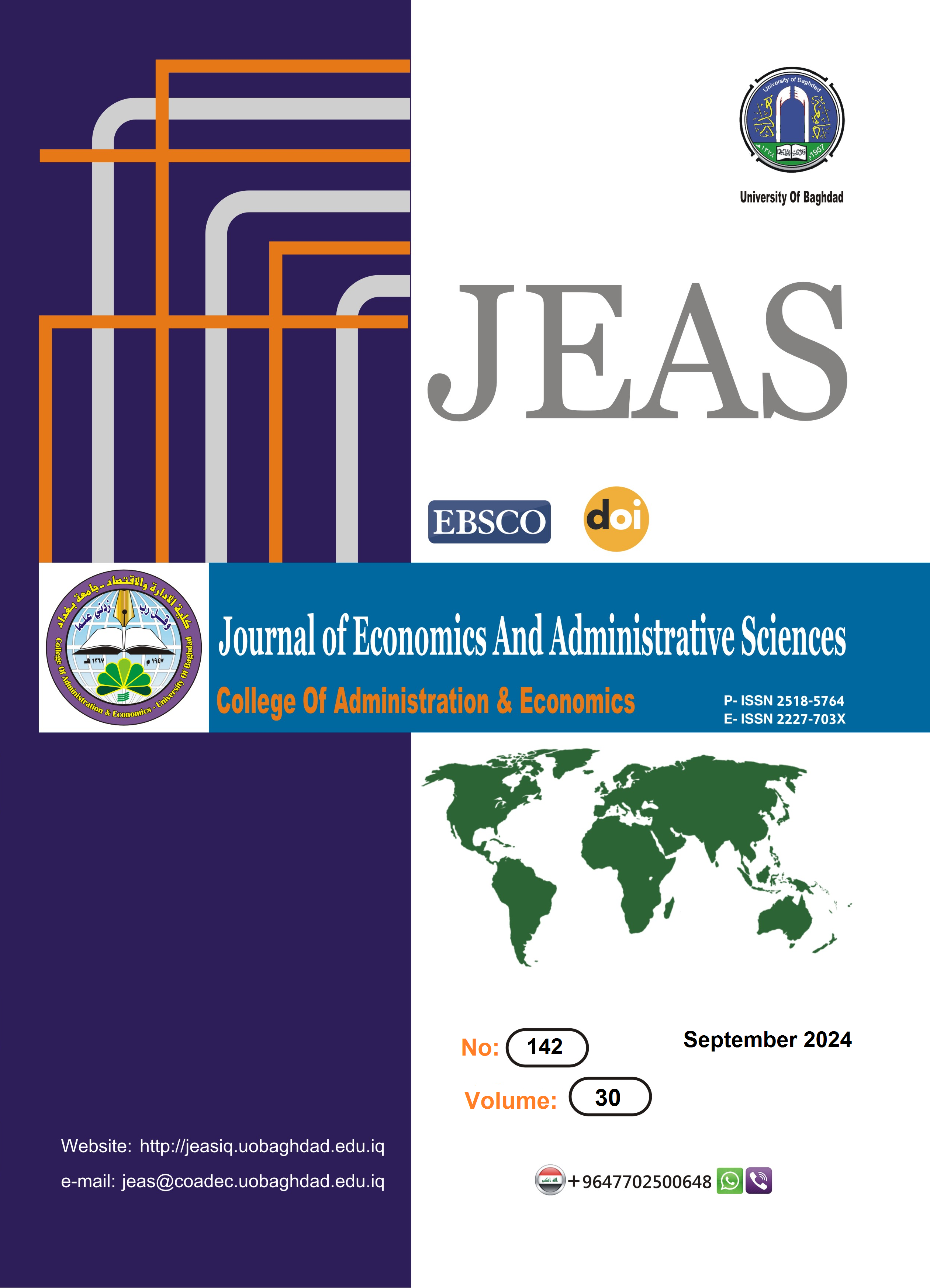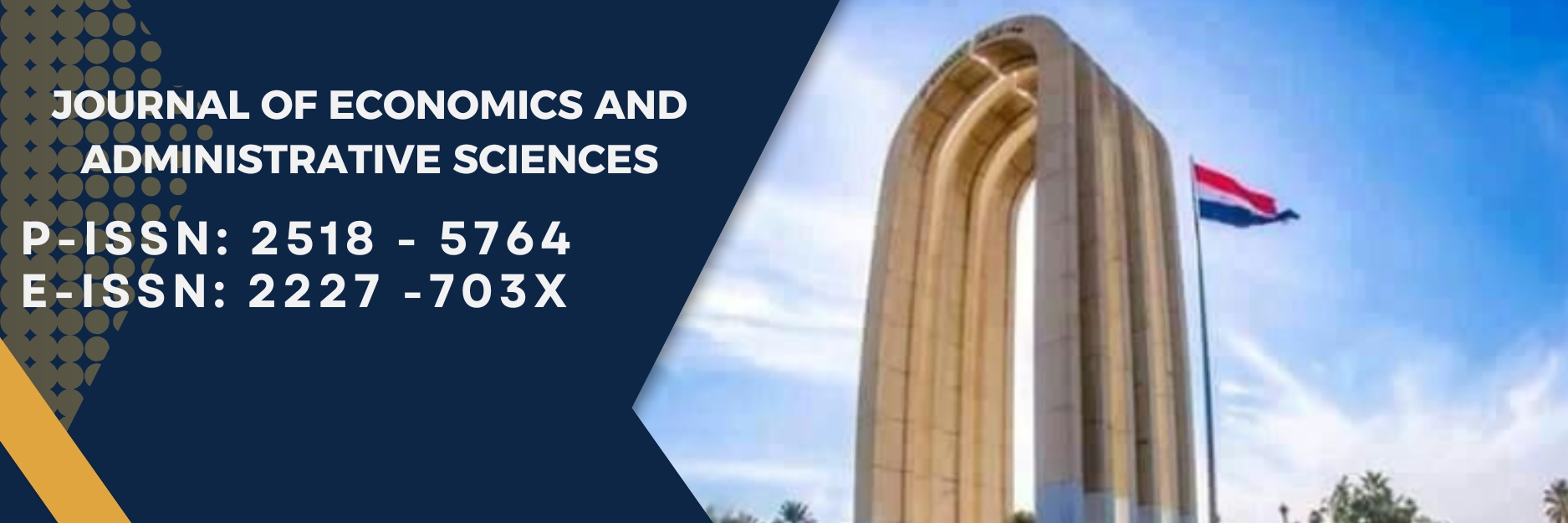Comparison of Estimation Methods for Zero Truncated Poisson Regression Model
DOI:
https://doi.org/10.33095/7bt1f714Keywords:
Zero-Truncated Poisson Distribution , The Iterative Reweighted Least Squares method , the Gauss -Newton method and the Newton –Raphson Algorithm Method Embedded in Maximum Likelihood , Mean square error .Abstract
Count data represents a number of defined events that occur within a specific time frame for explanatory variables in the form of integers, and discrete distributions are among the probability distributions that use count data. The most famous of these distributions is the Poisson distribution. However, sometimes a change in the pattern of the random variable period may occur, such as the absence of the zero value, which requires finding a distribution that fits such a change, and that is the Zero Truncated Poisson Distribution (ZTPD).
This research aims to find a suitable model for the effect of non-zero value of data on any phenomenon and to use it to build a Zero Truncated Poisson Regression Model. This is done by selecting the best method out of three methods: Gauss-Newton (GN), Iteratively re-weighted least squares (IRWLS), and the Newton-Raphson algorithm method embedded in Maximum Likelihood (N-RAMEML), using the Mean Square Error (MSE) criterion, by simulating the Monte Carlo method using the R language program. This is done by changing different factors such as sample size (30, 70, 100, and 150) and the number of explanatory variables, repeating each experiment 1000 times. The study showed that the IRWLS method outperforms the N-RAMEML and GN methods.
Paper type: Research paper
Downloads
References
References:
- Abbas, H. K. and Ahmed, D. A. (2020). “Use The moment method to Estimate the Reliability Function of the Data of Truncated Skew Normal Distribution”, Journal of Economics and Administrative Sciences, Vol.26, No. 124, pp. 481-492.
- Abody, E. H. and Nuimai, A. B. (2016). "Comparison Between Two Approaches (MLE & DLS) to Estimate Frechet Lindley Poisson Distribution Compound by Using Simulation", Ibn Al-Haitham Journal for Pure & Application Sciences, Vol. 29, No. 3, pp. 401-414 .
- Al-doori, E. A. and Muhammed, N.A. (2017). “Comparison of some methods for estimating Poisson-Weibull distribution parameters”, Journal of Economics and Administrative Sciences, Vol. 23, No. 101, pp. 452-475.
- Al-doori, E. A. (2018). “New Robust Estimation in Compound Exponential Weibull-Poisson Distribution for both contaminated and non-contaminated Data”, journal of Economics and Administrative Sciences, Vol. 24, No. 126, pp. 30-48 .
- Al-Shareefi, S. N. and Al Baldawi, T. H.(2023).“A Computational Bayesian Approach to the Poisson Regression Models and the Proportional Hazard Models”,AIP Publishing Conf. Proc.2834, pp.080146,1-14.
- Best, D. J. and Rayner, J.C. and Thas O. (2007). “Goodness of Fit for the Zero Truncated Poisson Distribution”. Journal of Statistical Computation and Simulation Vol. 77, No. 7, pp. 585-591.
- David, F. N. and Johnson, N. L. (1952). "The Truncated Poisson" International Biometric Society, Vol. 8, No. 4, pp. 275-285.
- Fishman, G.D. and Gross, D. (1976). “Concepts and Methods in Discrete Event Digital Simulation”. IEEE Transactions on Systems, Man, and Cybernetics Vol.: SMC-6 Issue: 5.
- Green, P. J. (1984). "Iteratively Reweighted Least Squares for Maximum Likelihood Estimation, and some Robust and Resistant Alternatives". Journal of the Royal Statistical Society: Series B (Methodological), Vol. 46, No. 2, pp. 149 -170.
- Handique, L. and Chakraborty, S. and Eliwa, M.S. and Hamedani, G.G. (2021). “Poisson Transmuted-G Family of Distributions: Its Properties and Applications”, Pakistan Journal of statistics and Operation research Vol. 17, No. 1, pp. 309-332 .
- Irshad, M. R., Chesneau, C., Shibu, D. S., Monisha, M. and Maya, R. (2022).“Lagrangin Zero–Truncated Poisson Distribution: Properties Regression Model and Application :”, Symmetry ,Vol.14,No.1775,pp.1-25.
- Kadhum, M. K. and Abdullah, E. K. (2021). "Estimating the Parameters of the Poisson Distribution with Application", Tikrit Journal of Administration and Economics Sciences, Vol. 17, No. 56 Part (4), pp. 547-557.
- Li, X. and Sun, Y. and Tian G. and Liang J. and Shi J. (2023). “Mean Regression Model for the Zero – Truncated Poisson Distribution and its Generalization”, Computational Statistics and Data Analysis, ELSEVIER, Vol. 179, pp. 107650.
- Manjula, D. and Uma, G. and Nandhinidevi, R. (2020). “Derivation of Zero –One Truncate Poisson Distribution”. International Journal of Applied Research Vol. 5,No. 6, pp. 253-255.
- Mohammed, A. H. and Hussain, J. E. (2017). “Analytical Study Compared Between Poisson and Poisson Hierarchical Model and Applied in Healthy Field”, Journal of Economics and Administrative Sciences Vol. 23, No.100 .
- Mohammed, J. M. and Hamodi, H. A. (2017). “Comparison count regression models for the number of infected of pneumonia” Global Journal of Pure and Applied Mathematics Vol. 13, No. 9 , pp.5359-5366.
- Mohammed, A. H. and Hussain, J. E. (2017). “A comparison between Bayesian method and full maximum likelihood to estimate Poisson regression model hierarchy and its application to the maternal deaths in Baghdad”, Journal of Economics and Administrative Sciences Vol. 23, No.101.
- Niyomdecha, A. and Srisuradetchai, P. (2023). “Complementary Gamma Zero-Truncated Poisson Distribution and Its Application”, Mathematics, Vol.11, No. 11, pp. (1-13) 2584.
- Shanker, R. and Shukla, K. K. (2019). “A Generalization of Zero-Truncated Poisson-Sujatha Distribution”, Hungarian Statistical Review Vol. 2, No. 2, pp. 32–50.
- Shamsur, R. and Mohd, Y. (2005). “Truncated Distributions and their Applications”. Dissertation submitted for the award of the degree of master philosophy in statistics in Department of statistics and Operations Research Aligarh Muslim University (India) (https://core.ac.uk/download/pdf/144520251.pdf).
- Kim, T. , Kim, D. S., Park, J., Lee, S., Park, S., ALqawba, M. S. and Jang, L. (2022). “Some Results on r-Truncated Degenerate Poisson Random Variables”, World Scientific Publishing Company Vol. 30, No. 10 , pp. 1-7 .
- Lai, W. H., Kek, S. L. and Tay, K. G. (2017). “Solving Nonlinear Least Squares Problem Using Gauss-Newton Method”, International Journal of Innovative Science, Engineering & Technology, Vol. 4, No. 1, pp. 107650.
- Yong, W. (2012). “Gauss–Newton method”. Department of Statistics, The University of Auckland, Auckland, New Zealand, Wiley Periodicals, Inc. Vol. 4 No. 4 , pp. 415-420.
Published
Issue
Section
License
Copyright (c) 2024 Journal of Economics and Administrative Sciences

This work is licensed under a Creative Commons Attribution-NonCommercial-NoDerivatives 4.0 International License.
Articles submitted to the journal should not have been published before in their current or substantially similar form or be under consideration for publication with another journal. Please see JEAS originality guidelines for details. Use this in conjunction with the points below about references, before submission i.e. always attribute clearly using either indented text or quote marks as well as making use of the preferred Harvard style of formatting. Authors submitting articles for publication warrant that the work is not an infringement of any existing copyright and will indemnify the publisher against any breach of such warranty. For ease of dissemination and to ensure proper policing of use, papers and contributions become the legal copyright of the publisher unless otherwise agreed.
The editor may make use of Turtitin software for checking the originality of submissions received.


























